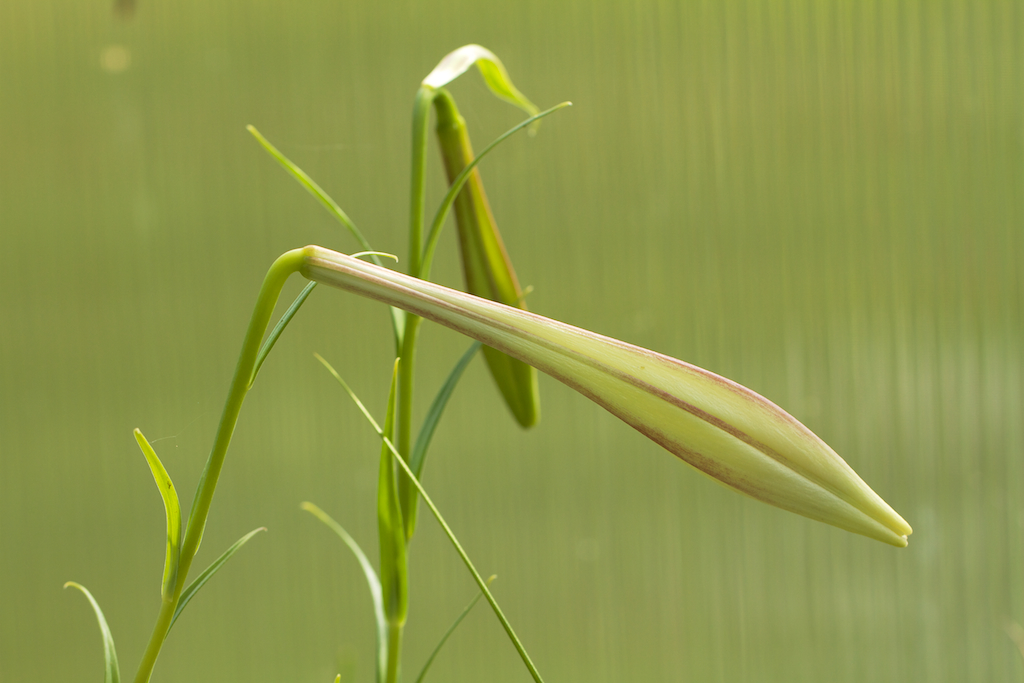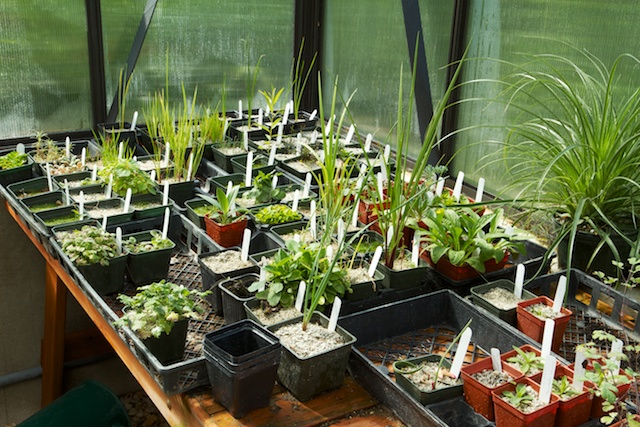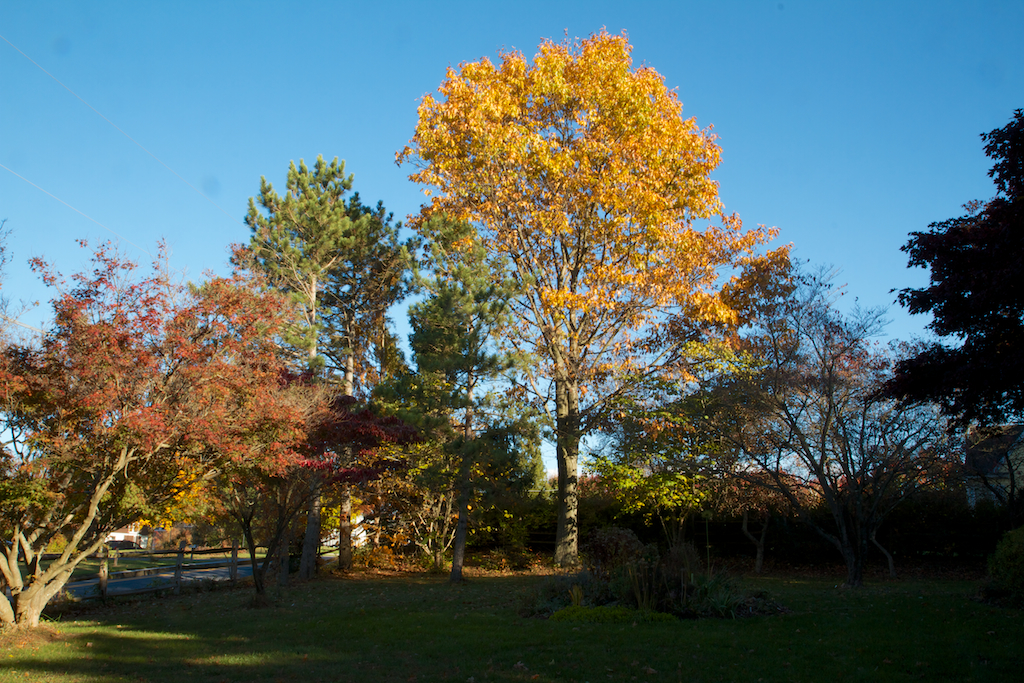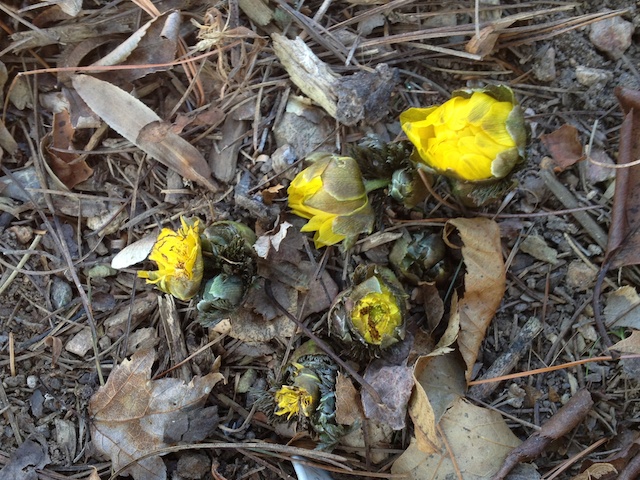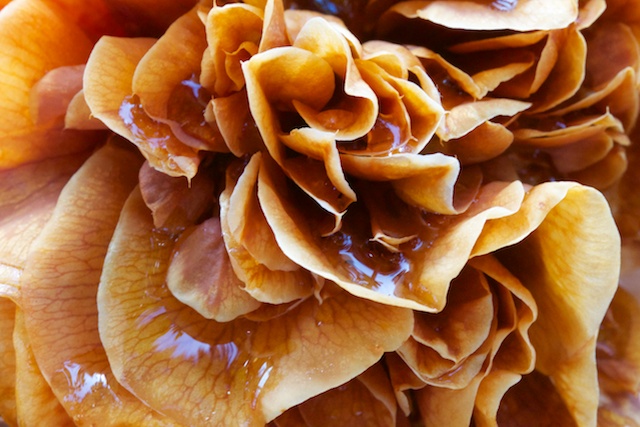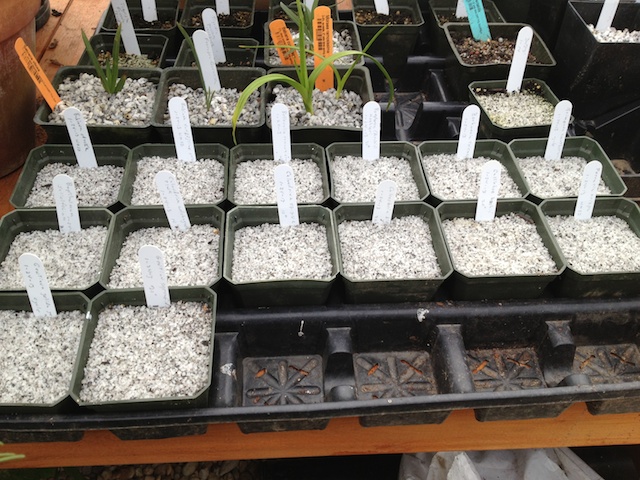Besides being beautiful flowers, what do the above lewisia, lobelia, erodium, lily, gentian, and calandrinia have in common? All were grown from seed distributed through the various plant societies. Specifically I participate in seed exchanges that are conducted by The North American Rock Gardening Society, The Alpine Garden Society, The Scottish Rock Garden Club, the Pacific Bulb Society, and the Species Iris Group of North America. Each of these organizations brings access to seeds that are otherwise very difficult to come by. This year I’ve already received my NARGS distribution of 35 seed packets and many choice elements are going to get planted this week. It includes Linum elegans, Bukiniczia cabulica, Eranthis pinnatifida, and many other items that you probably won’t find in the average seed catalog. I’m still waiting for my packages from the Alpine Garden Society to see which items I succeeded in getting. You get to choose from thousands of varieties of seeds but which ones you get depends upon when you sent in your request and whether you were a donor or not. In the past I’ve gotten over half of my first choice varieties even though I am not a donor for the overseas societies.
Besides the wealth of interesting seeds from the seed exchanges there are also other interesting sources of unusual seeds. We subscribed this past year to Chris Chadwell’s 29th expedition to the Himalayas in search of seeds. Our distribution arrived this month with 50 different seed packets gathered in Nepal.
In order to bring in seeds from overseas you need to apply to the USDA for permit for a small lots of seed import permit. And you need to be cognizant of which seeds are restricted. I’ve found the USDA folks to be very helpful and cooperative. I got a phone call on the day after New Year’s asking for clarification on the shipping address for my shipment from Chris Chadwell.
There are also some other wonderful sources of seeds gathered in the wild. I think in particular of Allen Bradshaw at Alplains who specializes in seeds gathered in the western U.S. Or Bjørnar Olsen from Norway who gathers seeds in China. There are a number of famous collectors in the Czech Republic. One I’ve used is Vojtech Holubec who has the most amazing pictures of his travels in asia.
More recently I was researching a Delphinium (Delphinium tatsienense to be precise) that is in my NARGS seeds for this year and I came across a very nice website in Canada (BotanyCa) that specializes in wild-collected seeds. She has choice list of seeds for sale and a lot of information about propagation and plant lore. Highly recommended.
The bottom line for all these ramblings is that now is the time for acquiring and planting all those unusual plants that you have been meaning to grow.
A Winter that calls for a Greenhouse
The weather has been crazy cold for us this year. Extended low temperatures beyond recent memory. The ice storms last week left a lot of people without power but we were fortunate in only being out of power for four hours. Actually we were doubly fortunate in being out in California for ten days so we mostly read about the cold weather while we were in our shirtsleeves enjoying the sunshine.
Our place of refuge with this kind of winter has been the greenhouse.
From within the greenhouse we can generally count on 60 degrees or more on a sunny day no matter how could it is outside.
Part of what I’ve been doing in the greenhouse is planting all the seeds from the various seed exchanges I’m involved in (the Scottish Rock Garden Club, The Alpine Garden Society, the North American Rock Garden Society, The Species Iris Group of North America) and some unusual seeds from Alplains in Colorado and The Gothenburg Botanical Garden. I’ve been iterating on the seed mix and the pots that I use, now pretty much tending to 3 1/2 inch pots that are extra deep with a mix of sand, miracle-gro potting mix, and turface. I lay the seeds out on the surface and then cover them with medium sized gravel.
So far I’ve planted 97 separate species and cultivars with another 34 in hand for planting. The first ones were put in on January 18th and the draba and dianthus are sprouting. This is an enjoyable part of the season just to see what has popped up each day.
An interesting encounter in the greenhouse a couple of weeks ago came from looking closely at a pot of Herbertia (relatives of Tigridia and Cypella) which seemed to be going very dormant. I was uncertain as to whether the Herbertia tigridioides that I planted last May was actually going dormant or just dying off. When I lifted the pot I noticed a little bulb trying to escape the pot.
When I emptied out the pot I found that not only was the Herbertia not dying but it had grown quite vigorously over the summer.
Apparently these are bulbs that like to dig themselves in deep. I’ve separated them into several deeper pots and we’ll see how they do with flowering this year.
We’re expecting another 10 inches or so of snow tonight so I may have to content myself with the greenhouse for a while longer. We did get to visit Anza-Borrego while we were in California last week so I will leave with a tidbit from that trip and a promise of more to come.
It’s Fall, Time for a New Project…
It’s fall on Ball Rd and you can’t miss the Red Maples, both red leaved and yellow that are in full color on our hillside. Just walking around reminds one that this is good time to stop and enjoy the ephemeral delights of autumn.
However, I was rudely reminded of some other aspects of fall when I went to check on my seedling trays which have spent the summer out of doors. Several of the pots, including valuable hepatica and peony seedlings were completely dug up. This was most likely by squirrels looking for a place to bury nuts but could have been mice as well. In any case I was awakened from my autumnal reverie and reminded that I need to get busy on a long delayed project to provide a winter home for these seedlings.
At one time I had planned to build a cold frame next to the greenhouse but, as I thought about it, I realized that I don’t really need the protection from the cold. For these little seedlings I’m looking for what the experts call cycling, i.e., changing the temperature from above to below freezing and back again. For many seeds this is necessary to start the germination process. A cold frame does give you that but the usual approach to a cold frame means that you are out there every day raising and lowering the lid to prevent heat build up and watering as necessary. What seems like a simpler approach for my needs is a sand plunge bed with rodent protection. The sand helps to moderate the temperature fluctuations for the young plants. Think of a sandbox with a wire grill.
Accordingly I began digging last week.
You could do this with treated wood but I like the sense of permanence that stone brings so I decided to use the same stone that provided the foundation for my alpine bed.
My depth was limited by the extended foundation of the greenhouse wall so I ended up digging down just 2-3 inches to put the 7×11 inch blocks on end to form the wall. I used landscape adhesive to tie the blocks to one another. They won’t be facing a lot of pressure to move somewhere else so this should be adequate.
I made an effort to keep things level and so on, but this is not for show, it just has to function. By yesterday I had completed the basic bed and poured in sand.
Actually I poured in way too much sand as it turns out. After moving nearly a 1000 pounds of sand I’ve decided I could have done with half of that once the displacement of the pots comes into play.
So I’ve bagged up some of the sand that I put in and I’ll use that for phase two (a similar bed next to this one). The next step was squirrel protection.
As it turns out there’s new pvc board that works pretty well for screen frame. It’s lightweight, weather-proof, and doesn’t shade the plants.
So, as of today, the project is complete and ready to use. I hope to see hepatica seedlings in the spring and I will tell them what a lot trouble I had to go to this fall…
Hepatica Seeds
This spring I invested in two small and ridiculously beautiful double flowered Japanese Hepaticas from Thimble Farms in Canada.
They are the result of years of breeding in Japan. But even the less specialized Hepaticas are delightful to look at for their short flowering season in the spring.
And they are also sufficient reason to look into propagating them from seed. It turns out that Hepatica seed is best sown very soon after harvesting so that now is the time to be seeking it from whatever source you use. Or, alternatively, harvest your own Hepatica seed and pot it up now. I found some very good references online for harvesting Hepatica seed but I wasn’t quite sure what I was looking for. I had never actually observed them to fall in the garden. But this week I noticed the seed heads hanging over the neighboring pots were dropping little seeds on the gravel. As I fished them out with my knife, I knocked some more seeds loose and pretty soon I had a handful.
For the outside plants I ordered some paper tea bags with drawstrings that I could put around the seed heads and thereby catch them if I wasn’t there when they came loose.
While I was going through this process around the yard with some other interesting plants like the Adonis, I noticed a little seedling in the pathway.
In the over thirty years that those Tree Peonies have been in place this is the first time I’ve seen a seedling. Peonies are slow to develop from seed so this little guy is precious indeed.
After the cold has departed
We’ve just had a marvelous mid-sixties day as we closed out the cold spell that hit us for the end of January. Although temperatures down to the very low teens is not unexpected for January we have gotten terribly spoiled by the mild winters that have been our lot of late. We got jerked back to zone 7 reality with a week of very cold (for us anyway) weather, where temperatures hit a low of 12 degrees last Wednesday and then stayed bitterly cold through a couple of small snowstorms. The Adonis and Camellias were the main plants that had really jumped the gun with regard to bloom cycle so I wasn’t sure how they would handle the really cold weather. I ended up putting some leaves over the Adonis but I’m not sure that it was necessary. Although they were folded up and bent over during the worst of the cold, they seem to have been completely unfazed by the temperatures.
Note that the apparently burned off blossoms were there before the cold wave and were probably animal related damage (I hope that pest got a severe stomach ache as flowers in the ranuculus clan are generally pretty unappetizing). A heavy snow or ice could probably damage the blossoms but it seems that straight old cold temperatures are not a problem.
I can’t say the same for the double pink Camellia as all those blossoms are now brown instead of pink.
Hard to complain though. We’ve many weeks and many flowers from this Camellia already this year. The Camellia sasanqua was a little more colorful after the cold, but the blossoms are sort of like paper maché. They don’t have their normal softness.
I used the warm weather to get a load of compost from the local landfill and start on some of the spring chores.
It was literally tee-shirt weather so I began building up the area where a tree fell down during Sandy. I expect we will want to do more gardening in that area since the light will be improved and there will be fewer pine roots to compete with.
Last Friday I had gone with a friend down to Behnke’s nursery in Beltsville, Maryland to help with the North American Rock Garden Society seed exchange process. It was interesting to see how organized one has to be to distribute 3500 different kinds of seeds to 750 people around the world.
Later I received and planted my own set of seeds received from NARGS and from the Scottish Rock Garden Club.
Many of these seeds are quite challenging to grow but that’s part of what makes it interesting.
Garden Blogger’s Bloom Day July 2012
Well it’s full-blown summer now for Garden Blogger’s Bloom Day and there is no difficulty in finding flowers in bloom. I shared our wealth of lilies a few days ago so I think it’s only fair to look at some of the other flowers that are strutting their stuff right now.
As is our custom we have a couple of rows of annual flowers just for picking in the garden, including zinnias, marigolds, cosmos, nasturtium, and sunflowers as well as a bunch of gladiolus that carried over from year to year.
The Cosmos and Zinnias are both so easy to grow from direct seeding in the garden and they provide so many pretty colors for arrangements.
The sunflowers provide a similarly long period of bloom and pickable flowers for the inside.
The sunflowers also have tremendous interest for the birds and bees. If you let them go to seed they become a magnet for goldfinches and indigo buntings. And the zinnias and cosmos are frequented by butterflies, bees, and hummingbirds. The hummingbirds can also be seen hovering near the gladiolus. Two of my favorite glads are ‘Margaret Rose’ and ‘Jester’ which are mirror reversed colors.
The glads can be found all around the house right now.
Other annual flowers that are brightening the garden right now are the Cleome and Celosia.
This is the Celosia ‘Flamingo Feather’ and it seems to have a particular appeal for a wide variety of insects. For some reason it is twice as tall (at least 3 feet) as the nominally same plant that I grew last year. It has totally outgrown its spot on the edge of the front garden (notice it behind the black-eyed susans).
Now it would not fair to the garden if I didn’t share some perennials too. The Joe-Pye weed is getting taller every day.
Don’t you wonder what they called this beauty before Joe Pye started dispensing it as a medicine?
The crocosmia are starting to fill in behind the lilies. The biggest patch that we have is ‘Lucifer’ with as brilliant a red as you are going to find.
I suppose if you wanted to increase your Crocosmia, you could dig these in the fall and spread out the little corms, but even just left alone they seem to be multiplying just fine. The only difficulty is keeping them upright as they have predilection for flopping.
In the front garden we’ve planted another Crocosmia, ‘Walcroy’, which has a brilliant orange/yellow color.
Think of the Crocosmia as miniature glads that are very hardy and productive. I am enjoying them more every year.
Let me finish this posting with a brilliant red daylily. I don’t know the variety, but I do know that year after year it continues to display the kind of red that most daylilies lust after and don’t achieve.
I’m sure this came from the kids in Boston, the source of many good things…
I also want to encourage readers to visit May Dreams Gardens to see what other bloggers are growing and to follow Carol’s pilgrimage to Elizabeth Lawrence’s house in North Carolina. Since in a very real sense that is the source of Garden Blogger’s Bloom Days, it’s worth reading about her quest for the root of it all.
Just In Time Planting
As of yesterday we were getting a bit impatient with the progress on the vegetable garden. The steady rains have been great for the perennial gardens but I still hadn’t gotten many of the vegetables planted. And several days of sunshine had helped but when I tried tilling on Saturday it was still too wet. When we woke up the weather had changed and was showing another rainstorm in the offing. I went out first thing to the garden and gave the ground another once over with the tiller. This time the soil was right — just crumbling in the hand as I squeezed it. So I ran the tiller plow down the rows and then tilled once more for most of it. I also removed one of the local inhabitants to protect him from the tiller.

Eastern Box Turtle (Terrapene carolina)
Then I broke out the seeds and plants. The snap peas had failed miserably compared to the standard snow peas, so I replanted them in part of the space and then added pole beans as well. The sunflowers went in for general flower picking and to participate in the Great Sunflower Project. For the main flower picking row I put in zinnias, marigolds, cosmos, cleomes, stocks, and a host of wildflower seeds from Wildseeds. May the best flower win!
Then I put in 3 kinds of squash, pumpkins, and 2 kinds of cucumbers. Finally I got to the seedling plants that had been hardened off on the porch. There were 18 tomatoes (mostly Jetstar and Supersonic with Primetime, Juliet, and Grape thrown in), 16 peppers (Declamation, Boynton, Big Bertha, Yellow Pimento, Red Pimento, and Carmen), and 9 Eggplants (Hansel, Gretel, Fairytale, Little Fingers, and Classic). Curiously, although the eggplants have been sitting on the back deck for nearly 2 weeks, no sooner did I put them in the garden than they were immediately attacked by flea beetles. The latter have become a major pest for eggplant. They devastate the leaves which look like they have been hit by a shotgun. I thought it was amazing that the limit their range to the garden and not to the yard. We may try growing some in pots. As I did the final planting (the corn will have to wait for another day) the raindrops started in by about 1pm.

The newly planted vegetable garden as seen today
And by 4pm we had a drenching rain. I was really glad that the timing worked out to get such a fine start for the seeds.
Bad Dreams and Garden Seeds

The Garden Picking Basket
I don’t know how many of you have ever had the classic bad dream where you are sitting down to take your final exam and you realize that you forgot to go to any of the classes. Well I just had the horticultural equivalent last night. I dreamt that it was July (wishful thinking in the cold of January) and I had forgotten to plant the corn and tomatoes. Oh-my-God, what a bad thought that was. What had I done with all those months that made me forget to plant those key elements in the vegetable garden?
Anyway, I took that as a sign and today I dug through the pile of catalogs on the floor, found all the ones related to seeds, and ordered many of the same things I regularly get from Harris and Stokes (standard veggies, some experiments like the new Emerite Pole Bean and Discovery Chard from Stokes, and cutting flowers in quantity for the vegetable? garden). So I’ve covered the basics now and should be able to sleep more calmly tonight. And at the same time, I’m now free to look at some of the other seed companies with more leisure. In particular, I’m very taken with Diane’s Flower Seeds which has both of the grasses I was looking at for this — the Mexican Feather Grass (Nassella tenuissima) and the Northern Sea Oats (Chasmanthium latifolium). And then there’s the American Horticultural Society’s Annual Seed Exchange. And we’ll see what else occurs to me over the next couple of weeks.



